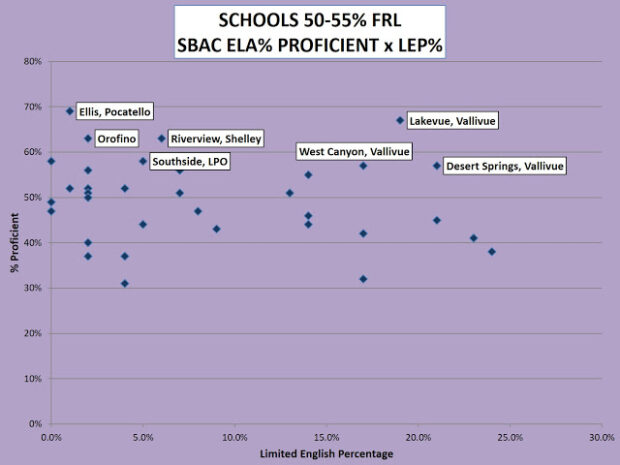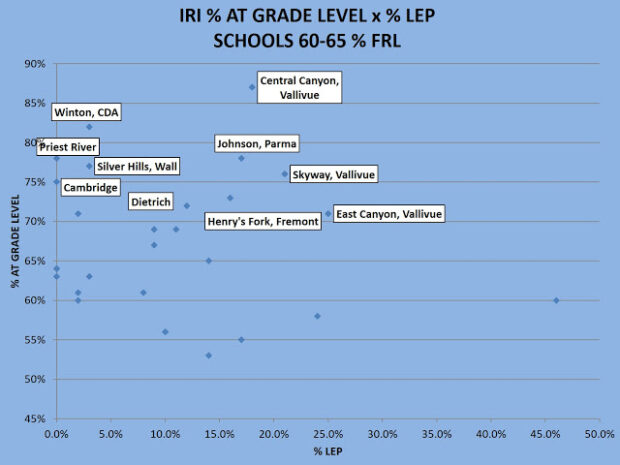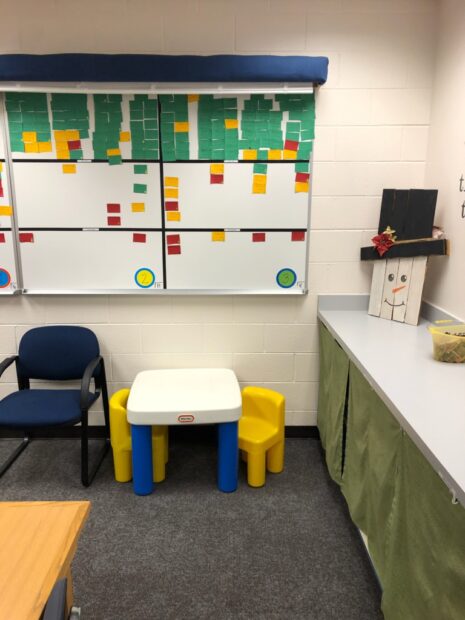Recently, Governor Little’s Task Force approved five recommendations, including one that proposed comparing results for schools with similar demographics. Idaho Ed News reported this task force statement: “Using similar cohorts of students, for comparison purposes, allows parents, education stakeholders, and state policymakers to compare the success of our schools and measure continuous improvement in a fair and unbiased manner.”
So, then, how can we develop a statewide strategy that would allow us to recognize the efforts of high achieving schools across the demographic spectrum, and find out just what those schools are doing?
Well, we can use demographic “slices” to look at academic performance and identify practices used by top performing schools in those “slices”. And, of course, using Idaho’s School Report Cards, we at RISE have done that for almost all of the elementary schools in the state of Idaho.
In our analysis we have used status percentages in lieu of growth, because of the lack of cohort information and other issues with growth data, such as scaling issues on the IRI. And we have focused on more than one assessment to paint a picture of school performance, because that has been a sticking point for Idaho educators in the past.
We broke down free/reduced lunch “slices” for various percentages of free/reduced lunch schools (0-20%, 20-25%, 25-30%, 30-35%, etc.), created a special category for CEP schools, (those that qualify under federal guidelines to feed all kids), and looked at performance on SBAC ELA and SBAC Math, and on the IRI. All free/reduced lunch eligibility percentages came from the 2018-19 Lunch Eligibility Report from the State Department of Education. The results were fascinating.
The Charts
For example, we analyzed the data for schools that had 50-55% free/reduced lunch, and then used the percentage of students at grade level/proficient as the y-variable and the percentage of Limited English students as the x-variable in a scattergram, and identified the “high flying” schools. This was the result.

This chart was for SBAC ELA, but the results were similar for SBAC Math and for the IRI. For schools with fewer than 10% ELA, Rulon Ellis Elementary in Pocatello. Riverview In Shelley (grades 3-4), Orofino, and Southside in Lake Pend O’reille, were high performers for this demographic. For schools with more than 10% Limited English students, here of Vallivue District’s schools were top achievers: Lakevue, West Canyon, and Desert Springs. Now granted, the difference between these schools and some others in a “slice” may have only been a few percentage points, but it gave us an idea of some schools that are making a difference for kids.
When we looked at 60-65% FRL, here’s what we found:

These are results for the Spring IRI, but, again, the top schools tended to perform well across assessments. For fewer than 10% LEP, Winton Elementary in Coeur d’Alene, Silver Hills in Wallace, Priest River in West Bonner, Cambridge, and Dietrich were top achievers. For schools with more than 10% LEP, Maxine Johnson Elementary in Parma, Henry’s Fork in Fremont County, and three Vallivue schools, Central Canyon, Skyway, and East Canyon showed excellent achievement.
For the record, Vallivue’s other elementary school, Birch, was also a high performer in the 40-45% free/reduced lunch category.
So, what’s Vallivue doing?
We were curious to find out just what Vallivue’s elementary schools are doing that produces top results compared with demographically similar schools. So we asked Vallivue Deputy Superintendent Lisa Boyd to set up a meeting with some principals who could provide us with a view of their successful strategies. Superintendent Pat Charlton attended, as did Curriculum Director Cindy Johnstone and four district principals.

At first, the administrators were reluctant to talk – educators are not often asked about the basis for their successes. But after a few minutes, they opened up and we learned a lot about Vallivue. Here were some of the successful strategies they identified:
- AVID – Vallivue has fully implemented this proven strategy, and is the only Idaho district making extensive use of the program in the elementary grades.

- Consistent, Regular Tracking of Results – The District has developed strategies for checking on student progress regularly, and sharing progress.

- Use of Instructional Coaches – Vallivue uses these coaches to provide curricular assistance, instructional help, and assessment interpretation.
- High Expectations – Vallivue is known for establishing high expectations for administrators, teachers, and kids. It’s a culture that promotes high achievement, respect, and dignity from the Superintendent to the classroom.
- Excellent Professional Development tailored to the needs of teachers and principals.
- Consistent, timely support for instructional needs in the classroom.
- Outstanding teachers and administrators.
- Buy-in to District standards for learning.
- Use of meaningful assessments, not of superfluous testing (whenever possible).
Wow, that’s a lot, and probably not enough detail for someone to adequately describe what’s working. However, Vallivue’s staff and administration is always willing to help. They are true professionals, and dedicated to excellence.
Written by Don Coberly and Wil Overgaard, co-CEOs of Rise TVEP.
